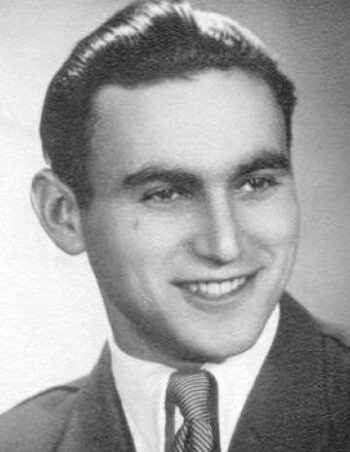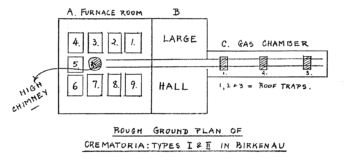Vrba, Rudolf

Rudolf Vrba (born as Walter Rosenberg, 11 Sept. 1924 – 27 March 2006) was a Slovakian Jew deported to the Majdanek Camp on 14 June 1942, and 16 days later, on 30 June, transferred to the Auschwitz Camp. Initially, he was employed at the inmate property warehouse of the Main Camp, sorting and registering the property which inmates brought along. Later, he served as a clerk in a section of Construction Sector II in Birkenau. He claims to have been involved in the camp’s clandestine resistance movement.
On 7 April 1944, he managed to escape together with Alfred Wetzler. They reached Slovakia, where their stories were typed up in a report that was first published in a German translation in Switzerland on 17 May 1944. Together with two other reports of three other escapees (Jerzy Tabeau, Czesław Mordowicz, Arnošt Rosin), the Vrba-Wetzler Report was published in English translations by the U.S. government as the so-called War Refugee Board Report. As such, the story told by Vrba and Wetzler about what was happening at Auschwitz was made known all over the world. Hence, the impact and thus the importance of this report for the formation of the orthodox Auschwitz narrative can hardly be overestimated.
Riding the Holocaust-propaganda wave triggered by the Eichmann Trial in 1961, a series of stories by Vrba was published in the British newspaper Daily Herald. Two years later, this series appeared as a book titled I Cannot Forgive, although it was at least partly ghost-written by the journalist Alan Bestic. Vrba testified during the Frankfurt Auschwitz show trial, and was interviewed by Claude Lanzmann for the documentary Shoah, although it does not contain any specific claims about the alleged extermination at Auschwitz or any information on how he has received information about it. His last testimony was during the First Zündel Trial in 1985 in Toronto, Canada.
Here are some of the most pertinent and peculiar claims made by Vrba in his report co-authored with Wetzler and in his book:
-

Rudolf Vrba’s freely invented floor-plan sketch of Crematoria II and III, as published with the War Refugee Board Report. Compare this layout with the real layout as shown in the illustrations contained in the Auschwitz-Birkenau section of the entry on Crematoria. A drawing attached to the report allegedly shows the layout of Crematoria II and III, which the text explains in more detail. However, it is all wrong:
- In their drawing, the furnace room shows nine furnaces with four muffles each arranged in a semi-circle around a chimney, when in reality there were five furnaces with three muffles each arranged in a straight line, at a good distance from the chimney.
- In their drawing, the two morgues (alleged undressing room and gas chamber) are on the same level as the furnace room, all arranged in a straight line. In reality, the furnace room was on ground level, the two morgues in the basement, arranged in a rectangle and linked via a hallway and vestibule.
- In their drawing, the gas chamber was linked to the furnace room with a set of rails, upon which carts filled with corpses were driven to the furnaces. In reality, a freight elevator transported bodies from the basement upstairs.
- The report claims that victims were issued towels and soap before entering the gas chamber. This most certainly would never have happened, considering the mess it would have created and the effort necessary to retrieve and clean these items afterwards. In addition, no one takes towels into a shower.
- The report claims that three bodies were cremated in a muffle at once within 90 minutes. However, adding several corpses into a muffle designed to burn one body in one hour would not have been possible already due to the small introduction door, and would have lasted much longer than 90 minutes.
- In total, Crematoria II and III each could allegedly cremate 2,000 corpses per day (which was also the claimed capacity of the undressing room). This stands in contrast to the actual theoretical maximum of some 300 bodies per day. Unhappy with this “low” cremation capacity compared to other survivor claims, Vrba doubled that to 4,000 per day in his 1963 book.
- The gas was poured into the room through “three traps,” while the orthodoxy insists on four Zyklon-B introduction devices.
- The time required for the gassing was only three minutes. However, in a facility without means to accelerate the evaporation of the liquid poison from the carrier material (Zyklon B) and the dissipation into the large room, such short execution times are physically impossible.
- Vrba claimed to have seen, counted and memorized the data of all transports of Jews that arrived at Auschwitz during his time at the camp, so that he could write the data down once he had escaped. Thus, a list in the report, which was admitted as Document L-002 at the Nuremberg International Military Tribunal (IMT, Vol. 37, p. 433), sums up the total numbers of inmates from every affected European country, who were allegedly gassed at Auschwitz between April 1942 and April 1944, resulting in a total of 1,765,000 victims. However, according to wartime documents analyzed by mainstream historians, in that same period, only a little over 500,000 Jews were deported to Auschwitz, not all of whom are said to have been gassed.
- In 1961, Vrba claimed that, according to his calculations, some 2,500,000 people were murdered at Auschwitz within three years – as opposed to the current orthodox figure of roughly a million for the entire camp’s existence.
- Vrba’s references to transports allegedly gassed and the bodies burned on pyres are not compatible with the documented or even the orthodox chronology. At the time this is said to have occurred (early 1942), open-air incinerations weren’t said to have commenced yet (they started in September 1942). Moreover, all deportees of transports he mentioned that arrived prior to July 1942 were registered and admitted to the camp, so there could not have been any gassings at all.
- The utterly wrong description of the crematoria proves that Wetzler and Vrba had not received any information in this regard, hence cannot have been in contact with any inmate working in those facilities, or if they were in touch with any such person, Vrba and Wetzler evidently never asked for a description, hence weren’t interested in facts. Instead, their whole description was invented from scratch, either by Vrba on his own accord or by the camp’s resistance movement, evidently without any input from crematorium workers. Yet Vrba claimed repeatedly that Sonderkommando members were the source of his information, and several survivors later claimed that crematorium workers had been in close contact with the resistance movement. One of them later even confirmed what Vrba had written in his book, that he had provided the data and even a floor plan of the crematorium to Vrba: the plagiarizer Filip Müller. In fact, several people involved in this plot told different, mutually contradictory stories about who gave what information to whom. None of them tell the truth. This story was made up from scratch, and everybody wanted a piece of the fame built on this lie, adding more layers of mendacity to the story.
- Although there is no evidence that Adolf Eichmann had ever been to Auschwitz, he is featured prominently in Vrba’s 1961 series of articles published opportunistically on occasion of Eichmann’s trial in Jerusalem. Vrba falsely stated that Eichmann visited the camp in 1942 and again on occasion of the inauguration of the first Birkenau Crematorium in early 1943, celebrating this event together with Himmler and his entourage. Both are completely invented stories.
- In the 1961 series of articles, Vrba promoted himself to a member of the Sonderkommando allegedly involved in exhuming the corpses of 20,000 Soviet PoWs – although only 12,000 Soviet PoWs ever reached Auschwitz.
- While he had no specific knowledge of the alleged murders at the so-called “bunkers” before 1961, in that year he promoted himself to a member of the Sonderkommando working there as well.
- Vrba saw an open-air incineration trench “half a mile long and 30 yards wide” being dug at Auschwitz, which is preposterous nonsense.
In his 1963 book I Cannot Forgive, Vrba ratcheted up his mendacity one more notch, circulating black propaganda and entangling himself in contradictions:
- Synchronized with Wetzler’s identical change in his 1964 book What Dante Didn’t See, Vrba also increased the cremation capacity by reducing the time it allegedly took to cremate three corpses from 90 minutes (1944) to 20 minutes.
- He claimed that he saw with his own eyes that Himmler visited Auschwitz in January 1943, who came to witness the gassing of not 8,000 Jews as in his 1944 report, but of only 3,000.
- The corpses were no longer hauled to the furnaces in carts on rails, but in special lifts (plural, although there was only one in each crematorium).
- The inmate labor force exhuming mass graves grew from 200 to 1,400 inmates.
(For more details, see Mattogno 2021, pp. 217-243.)
Compared to his report, articles and book, Vrba’s interview with Claude Lanzmann for the documentary Shoah is outright boring, as it contains no concrete claims about any alleged extermination activities. It centers mostly around Vrba’s story on how he tried to warn the inmates of the Theresienstadt Family Camp within Birkenau about their allegedly impending annihilation, as well as a detailed retelling of his escape and how his and Wetzler’s report came to be and was spread around the world. Interestingly, he did not claim that the information contained in his report was based on information he had received from Sonderkommando members. (Lanzmann 1985; Interview transcript at U.S. Holocaust Memorial Museum, reference RG-60.5016.)
There is an interesting footnote to the Lanzmann interview. In his book Pietà, Swedish Professor Georg Klein, a Jew originally from Hungary and as such himself a “Holocaust survivor,” told of a conversation he had with Rudolf Vrba in 1987. Klein reports about persecutions during the war, but that he had no knowledge of mass exterminations at the time. During his conversation with Klein, Vrba mentioned that he was once asked whether the horrible things he described in Lanzmann’s documentary Shoah were really true. Vrba answered that he didn’t know because he was only an actor reciting his lines. In his book, Klein wrote that he will never forget Vrba’s sardonic smile when retelling this exchange (Klein 1992, pp. 133f.).
Vrba’s final undoing occurred during the First Zündel Trial in 1985. During his testimony, Vrba once more insisted on the accuracy of his memory regarding the data he had provided in his 1944 report. However, when he was confronted with the inaccuracies and contradictions in his report and his book during cross-examination, he admitted several times to having used “poetic license” in his book. During re-examination, the prosecutor then asked Vrba:
“Have you used poetic license in your testimony?”
Vrba denied it, so the prosecutor asked him how he came up with his (false) figure of 1.765 million gassing victims, and Vrba went on a longwinded “explanation,” trying again to justify his lies. The prosecutor left it at that. Vrba never testified publicly again after that.
(See the exchange in Rudolf 2020b, pp. 287f.)

You need to be a registered user, logged into your account, and your comment must comply with our Acceptable Use Policy, for your comment to get published. (Click here to log in or register.)